Gigabyte Z390 Aorus Xtreme Waterforce operation manual

Z390 AORUS XTREME WATERFORCE
User's Manual
Rev. 1001
12ME-Z39XTRW-1001R
For more product details, please visit GIGABYTE's website.
To reduce the impacts on global warming, the packaging materials of this product are recyclable and reusable. GIGABYTE works with you to protect the environment.
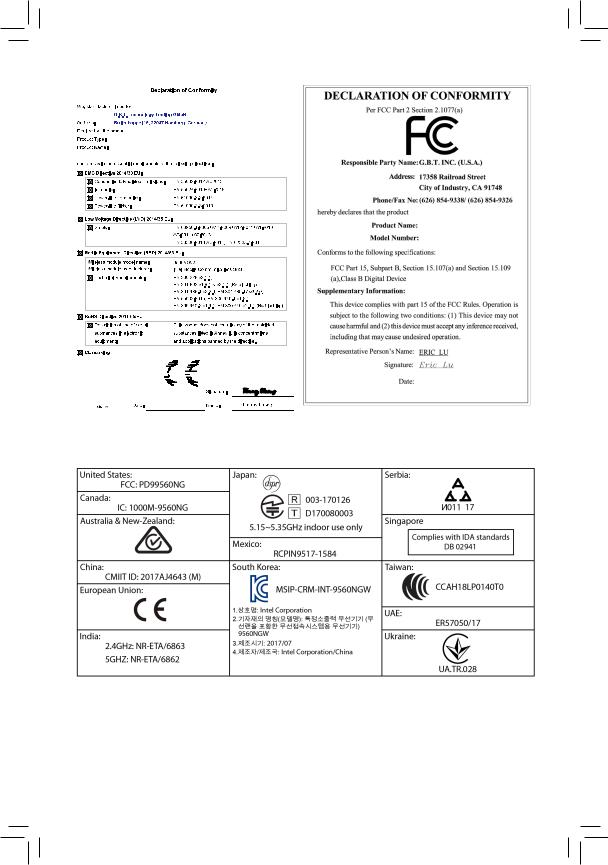
Motherboard
Z390 AORUS XTREME WATERFORCE
Nov. 30, 2018
Motherboard
Z390 AORUS XTREME WATERFORCE
Nov. 30, 2018
Wireless Module Country Approvals:
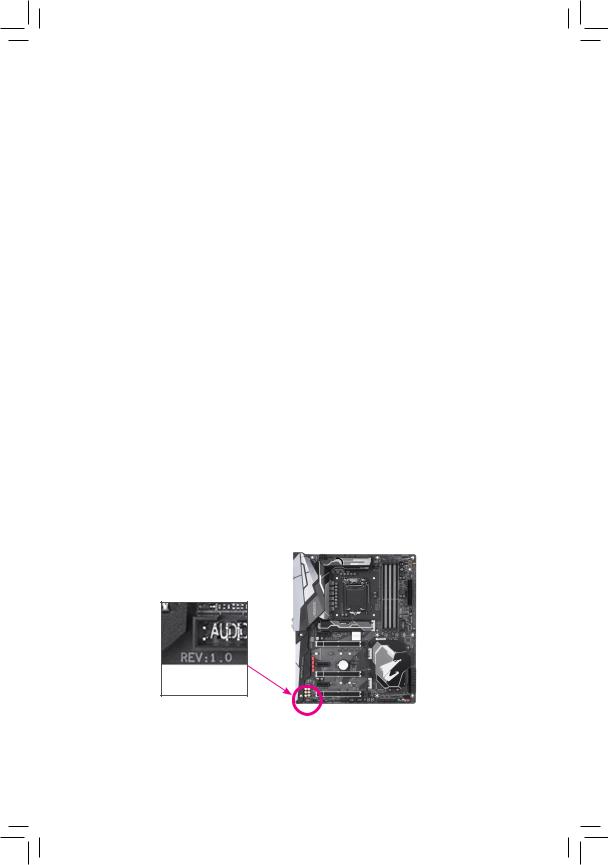
Copyright
© 2018 GIGA-BYTE TECHNOLOGY CO., LTD. All rights reserved.
The trademarks mentioned in this manual are legally registered to their respective owners.
Disclaimer
Information in this manual is protected by copyright laws and is the property of GIGABYTE.
Changes to the specifications and features in this manual may be made by GIGABYTE without prior notice.
No part of this manual may be reproduced, copied, translated, transmitted, or published in any form or by any means without GIGABYTE's prior written permission.
Documentation Classifications
In order to assist in the use of this product, GIGABYTE provides the following types of documentations:
For quick set-up of the product, read the Quick Installation Guide included with the product.For detailed product information, carefully read the User's Manual.
For product-related information, check on our website at: https://www.gigabyte.com
Identifying Your Motherboard Revision
The revision number on your motherboard looks like this: "REV: X.X." For example, "REV: 1.0" means the revision of the motherboard is 1.0. Check your motherboard revision before updating motherboard BIOS, drivers, or when looking for technical information.
Example:

Table of Contents
Box Contents.................................................................................................................... |
|
|
6 |
Optional Items.................................................................................................................. |
|
|
6 |
Z390 AORUS XTREME WATERFORCE Motherboard Layout....................................... |
7 |
||
Chapter 1 Hardware Installation...................................................................................... |
9 |
||
1-1 |
Installation Precautions.................................................................................... |
9 |
|
1-2 |
Product Specifications................................................................................... |
10 |
|
1-3 |
Installing the CPU and CPU Cooler............................................................... |
14 |
|
1-3-1 |
Installing the CPU................................................................................................... |
14 |
|
1-3-2 Installing the Water Cooling Kit.............................................................................. |
16 |
||
1-4 |
Installing the Memory..................................................................................... |
17 |
|
1-4-1 Dual Channel Memory Configuration..................................................................... |
17 |
||
1-4-2 |
Installing a Memory................................................................................................ |
18 |
|
1-5 |
Installing an Expansion Card......................................................................... |
19 |
|
1-6 |
Setting up AMD CrossFire™/NVIDIA® SLI™ Configuration............................. |
20 |
|
1-7 |
Back Panel Connectors.................................................................................. |
21 |
|
1-8 |
Onboard Buttons, Switches and LEDs........................................................... |
23 |
|
1-9 |
Installing the GC-OC Touch........................................................................... |
25 |
|
1-10 |
Internal Connectors........................................................................................ |
26 |
|
Chapter 2 BIOS Setup................................................................................................... |
41 |
||
2-1 |
Startup Screen............................................................................................... |
42 |
|
2-2 |
The Main Menu.............................................................................................. |
43 |
|
2-3 |
M.I.T................................................................................................................ |
45 |
|
2-4 |
System............................................................................................................ |
57 |
|
2-5 |
BIOS............................................................................................................... |
58 |
|
2-6 |
Peripherals..................................................................................................... |
61 |
|
2-7 |
Chipset........................................................................................................... |
64 |
|
2-8 |
Power.............................................................................................................. |
65 |
|
2-9 |
Save & Exit..................................................................................................... |
67 |
|
Chapter 3 Configuring a RAID Set................................................................................ |
69 |
||
3-1 |
Configuring SATA Controllers........................................................................ |
69 |
|
3-2 |
Installing the RAID/AHCI Driver and Operating System................................ |
83 |
|
3-3 |
Installing an Intel® Optane™ Memory.............................................................. |
86 |
|
Chapter 4 Drivers Installation........................................................................................ |
89 |
||
4-1 |
Drivers & Software......................................................................................... |
89 |
|
4-2 |
Application Software...................................................................................... |
90 |
|
4-3 |
Information..................................................................................................... |
90 |
|
- 4 -

Chapter 5 Unique Features........................................................................................... |
91 |
||
5-1 |
BIOS Update Utilities...................................................................................... |
91 |
|
5 |
-1-1 |
Updating the BIOS with the Q - Flash Utility ........................................................... |
91 |
5 |
-1-2 |
Updating the BIOS with the @BIOS Utility ........................................................... |
94 |
5 |
-1-3 |
Using Q - Flash Plus ............................................................................................... |
95 |
5-2 |
APP Center..................................................................................................... |
96 |
|
5 |
-2-1 |
3D OSD ................................................................................................................... |
97 |
5 |
-2-2 |
AutoGreen ............................................................................................................. |
98 |
5 |
-2-3 |
Cloud Station ......................................................................................................... |
99 |
5 |
-2-4 |
EasyTune .............................................................................................................. |
104 |
5 |
-2-5 |
Easy RAID ............................................................................................................ |
105 |
5 |
-2-6 |
Fast Boot ............................................................................................................... |
107 |
5 |
-2-7 |
Game Boost .......................................................................................................... |
108 |
5 |
-2-8 |
Platform Power Management ............................................................................... |
109 |
5 |
-2-9 |
RGB Fusion .......................................................................................................... |
110 |
5 |
-2-10 |
Smart TimeLock ................................................................................................... |
112 |
5 |
-2-11 |
Smart Keyboard .................................................................................................... |
113 |
5 |
-2-12 |
Smart Backup ....................................................................................................... |
114 |
5-2-13 |
Smart HUD ............................................................................................................ |
116 |
|
5 |
-2-14 |
System Information Viewer .................................................................................. |
117 |
5 |
-2-15 |
Smart Survey ........................................................................................................ |
118 |
5 |
-2-16 |
USB Blocker ......................................................................................................... |
119 |
5 |
-2-17 |
USB TurboCharger ............................................................................................... |
120 |
Chapter 6 Appendix |
..................................................................................................... |
121 |
|
6-1 Configuring Audio Input and Output............................................................. |
121 |
||
6 |
-1-1 |
Configuring 2/4/5.1/7.1 - Channel Audio ................................................................ |
121 |
6 |
-1-2 ....................................................................................... |
Configuring S/PDIF Out |
124 |
6 |
-1-3 ............................................................................................................. |
Stereo Mix |
124 |
6 |
-1-4 .................................................................................... |
Using the Voice Recorder |
125 |
6-2 |
Troubleshooting............................................................................................ |
126 |
|
6 |
-2-1 ............................................................................... |
Frequently Asked Questions |
126 |
6 |
-2-2 .................................................................................. |
Troubleshooting Procedure |
127 |
6-3 |
Debug .......................................................................................LED Codes |
129 |
|
Regulatory ............................................................................................Statements |
133 |
||
Contact Us............................................................................................................... |
139 |
||
- 5 -

Box Contents
55 Z390 AORUS XTREME WATERFORCE motherboard
55 One water cooling kit
55 One AORUS USB flash drive with drivers
55 User's Manual
55 Quick Installation Guide
55 Six SATA cables
55 Two Wi-Fi antennas
55 One GC-SLI2PL bridge connector
55 Two addressable LED strip adapter cables
55 One RGB LED strip extension cable
55 Two thermistor cables
55 One G Connector
55 One AORUS RGB Fan Commander
55 One GC-OC Touch
55 M.2 screw(s)/M.2 standoff(s)
55 One Velcro Cable Tie
*The box contents above are for reference only and the actual items shall depend on the product package you obtain. The box contents are subject to change without notice.
Optional Items
2-port USB 2.0 bracket (Part No. 12CR1-1UB030-6*R)eSATA bracket (Part No. 12CF1-3SATPW-4*R)
3.5" Front Panel with 2 USB 3.1 Gen 1 ports (Part No. 12CR1-FPX582-2*R)HDMI-to-DVI adapter (Part No. 12CT2-HDMI01-1*R)
- 6 -
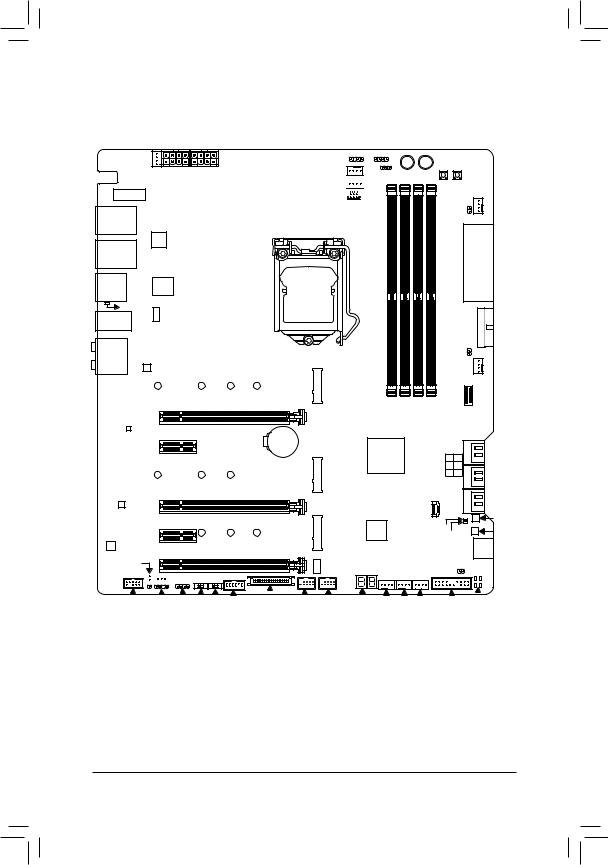
Z390 AORUS XTREME WATERFORCE Motherboard Layout
SYS_FAN1
|
|
CNVI |
TYPEC_1 |
USB31 |
LAN2 |
TYPEC_2 |
USB31 |
LAN1 |
 ATX_12V_2X4_2 ATX_12V_2X4_1
ATX_12V_2X4_2 ATX_12V_2X4_1
Intel® Thunderbolt™ 3
Controller
D_LED2 LED_C2 OC
CPU_FAN DLED_V_SW2
CPU_OPT 


LED_CPU 




LGA1151
PW_SW |
FAN6 PUMP |
RST SW CMOS SW EC TMP1 |
|
|
SYS |
ATX
USB HDMI |
Aquantia GbE |
|
LAN |
||
FBIOS_LED |
USB 2.0 Hub |
|
R_USB31 |
||
|
AUDIO
Intel® GbE
LAN
110 |
80 |
60 |
42 |
Z390 AORUS XTREME WATERFORCE
TI OPA1622 |
PCIEX16 |
|
|
|
|
|
|
BAT |
|
|
|
|
|
|
|
PCIEX1_1 |
|
|
|
|
110 |
80 |
60 |
|
ESS ES9018K2M PCIEX8 |
|
|
|
|
DAC |
|
|
|
|
|
PCIEX1_2 |
|
|
|
CODEC |
|
80 |
60 |
42 |
PCIEX4
SPDIF_O


 DLED_V_SW1
DLED_V_SW1
|
|
|
EC TMP2 F USB30 |
PUMP |
M2M |
DDR4 A1 DDR4 A2 |
DDR4 B1 DDR4 B2 |
F USB31C |
SYS FAN5_ |
|
Intel® Z390 |
|
1 0 |
|
M2A |
|
|
3 2 |
|
|
|
SATA3 |
|
|
|
|
|
5 4 |
|
|
LED_PCH |
|
B_BIOS |
|
|
iTE® |
|
|
|
M2P |
BBIOS_LED |
M_BIOS |
||
Super I/O |
|
MBIOS_LED |
||
|
|
|
OC_PEG |
|
USB 2.0 Hub |
|
CLR_CMOS |
|
|
|
|
|
||
|
|
|
|
|
|
|
|
|
|
|
|
|
|
|
|
|
|
|
|
|
|
|
|
|
|
|
|
|
|
|
|
|
|
|
|
|
|
|
|
|
|
|
|
F_AUDIO |
|
LED |
_C1 |
SB |
|
OCT_CON |
|
F_ |
USB1 |
SYS_FAN2 |
SYS_FAN4 |
|
CPU |
DRAM |
|||||||
|
|
D_ |
LED1 BIOS |
_SW TPM |
|
F_USB2 |
|
DB_PORT (Note) SYS_FAN3 |
F_PANEL |
VGA |
BOOT |
||||||||||
|
|
|
|
|
|
||||||||||||||||
(Note) For debug code information, please refer to Chapter 6.
- 7 -

- 8 -

Chapter 1 Hardware Installation
1-1 Installation Precautions
The motherboard contains numerous delicate electronic circuits and components which can become damaged as a result of electrostatic discharge (ESD). Prior to installation, carefully read the user's manual and follow these procedures:
•• Prior to installation, make sure the chassis is suitable for the motherboard.
•• Prior to installation, do not remove or break motherboard S/N (Serial Number) sticker or warranty sticker provided by your dealer. These stickers are required for warranty validation.
•• Always remove the AC power by unplugging the power cord from the power outlet before installing or removing the motherboard or other hardware components.
•• When connecting hardware components to the internal connectors on the motherboard, make sure they are connected tightly and securely.
•• When handling the motherboard, avoid touching any metal leads or connectors.
•• It is best to wear an electrostatic discharge (ESD) wrist strap when handling electronic components such as a motherboard, CPU or memory. If you do not have an ESD wrist strap, keep your hands dry and first touch a metal object to eliminate static electricity.
•• Prior to installing the motherboard, please have it on top of an antistatic pad or within an electrostatic shielding container.
•• Before connecting or unplugging the power supply cable from the motherboard, make sure the power supply has been turned off.
•• Before turning on the power, make sure the power supply voltage has been set according to the local voltage standard.
•• Before using the product, please verify that all cables and power connectors of your hardware components are connected.
•• To prevent damage to the motherboard, do not allow screws to come in contact with the motherboard circuit or its components.
•• Make sure there are no leftover screws or metal components placed on the motherboard or within the computer casing.
•• Do not place the computer system on an uneven surface.
•• Do not place the computer system in a high-temperature or wet environment.
•• Turning on the computer power during the installation process can lead to damage to system components as well as physical harm to the user.
•• If you are uncertain about any installation steps or have a problem related to the use of the product, please consult a certified computer technician.
•• If you use an adapter, extension power cable, or power strip, ensure to consult with its installation and/or grounding instructions.
- 9 - |
Hardware Installation |

1-2 |
Product Specifications |
|
|
|
|
|
CPU |
Support for 9th and 8th Generation Intel® Core™ i9 processors/Intel® Core™ i7 |
|
|
processors/Intel® Core™ i5 processors/Intel® Core™ i3 processors/Intel® Pentium® |
|
|
processors/Intel® Celeron® processors in the LGA1151 package |
|
|
(Go to GIGABYTE's website for the latest CPU support list.) |
|
|
L3 cache varies with CPU |
|
Chipset |
Intel® Z390 Express Chipset |
|
Memory |
4 x DDR4 DIMM sockets supporting up to 64 GB of system memory |
|
|
Dual channel memory architecture |
|
|
Support for DDR4 2666/2400/2133 MHz memory modules |
|
|
Support for ECC Un-buffered DIMM 1Rx8/2Rx8 memory modules (operate in |
|
|
non-ECC mode) |
|
|
Support for non-ECC Un-buffered DIMM 1Rx8/2Rx8/1Rx16 memory modules |
|
|
Support for Extreme Memory Profile (XMP) memory modules |
|
|
(Go to GIGABYTE's website for the latest supported memory speeds and memory |
|
|
modules.) |
|
Onboard |
Integrated Graphics Processor+Intel® Thunderbolt™ 3 Controller: |
|
Graphics |
- 2 x Intel® Thunderbolt™ 3 connectors (USB Type-C™ ports), supporting |
|
|
DisplayPort and Thunderbolt™ video outputs and a maximum resolution of |
|
|
4096x2304@60 Hz |
*Because of the limited I/O resources of the PC architecture, the number of Thunderbolt™ devices that can be used is dependent on the number of the PCI Express devices being installed. (Refer to Chapter 1-7, "Back Panel Connectors," for more information.)
*Support for DisplayPort 1.2 version.
Integrated Graphics Processor-Intel® HD Graphics support:
-1 x HDMI port, supporting a maximum resolution of 4096x2160@30 Hz
*Support for HDMI 1.4 version and HDCP 2.2.
Maximum shared memory of 1 GB
Audio |
|
Realtek® ALC1220-VB codec |
|
ESS ES9018K2M DAC and TI OPA1622 operational amplifiers |
|
|
|
* The front panel line out jack supports DSD audio. |
|
High Definition Audio |
|
|
|
2/4/5.1/7.1-channel |
|
Support for S/PDIF Out |
|
LAN |
|
1 x Aquantia GbE LAN chip (10 Gbit/5 Gbit/2.5 Gbit/1000 Mbit/100 Mbit) (LAN1) |
|
1 x Intel® GbE LAN phy (10/100/1000 Mbit) (LAN2) |
|
Wireless |
|
Intel® CNVi interface 802.11a/b/g/n/ac, supporting 2.4/5 GHz Dual-Band |
Communication |
|
BLUETOOTH 5 |
Module |
|
Support for 11ac 160 MHz wireless standard and up to 1.73 Gbps data rate |
|
|
* Actual data rate may vary depending on environment and equipment. |
Hardware Installation |
- 10 - |

Expansion Slots 1 x PCI Express x16 slot, running at x16 (PCIEX16)
* For optimum performance, if only one PCI Express graphics card is to be installed, be sure to install it in the PCIEX16 slot.
1 x PCI Express x16 slot, running at x8 (PCIEX8)
*The PCIEX8 slot shares bandwidth with the PCIEX16 slot. When the PCIEX8 slot is populated, the PCIEX16 slot operates at up to x8 mode.
1 x PCI Express x16 slot, running at x4 (PCIEX4)
*The PCIEX4 slot shares bandwidth with the M2P connector. The PCIEX4 slot operates at up to x2 mode when a PCIe SSD is installed in the M2P connector.
|
|
(All of the PCI Express x16 slots conform to PCI Express 3.0 standard.) |
|
|
2 x PCI Express x1 slots |
|
|
(All of the PCI Express x1 slots conform to PCI Express 2.0 standard.) |
|
|
1 x M.2 Socket 1 connector for an Intel® CNVi wireless module only (CNVI) |
Multi-Graphics |
|
Support for NVIDIA® Quad-GPU SLI™ and 2-Way NVIDIA® SLI™ technologies |
Technology |
|
Support for AMD Quad-GPU CrossFire™ and 3-Way/2-Way AMD CrossFire™ |
|
|
technologies |
Storage Interface |
Chipset: |
|
|
|
- 1 x M.2 connector (Socket 3, M key, type 2242/2260/2280/22110 SATA and |
|
|
PCIe x4/x2 SSD support) (M2M) |
|
|
- 1 x M.2 connector (Socket 3, M key, type 2260/2280/22110 SATA and PCIe |
|
|
x4/x2 SSD support) (M2A) |
|
|
- 1 x M.2 connector (Socket 3, M key, type 2242/2260/2280 PCIe x4/x2 SSD |
|
|
support) (M2P) |
|
|
- 6 x SATA 6Gb/s connectors |
|
|
- Support for RAID 0, RAID 1, RAID 5, and RAID 10 |
|
|
* Refer to "1-10 Internal Connectors," for the installation notices for the PCIEX4, M.2, |
|
|
and SATA connectors. |
|
|
Intel® Optane™ Memory Ready |
USB |
|
Chipset+Intel® Thunderbolt™ 3 Controller: |
|
|
- 2 x USB Type-C™ ports on the back panel, with USB 3.1 Gen 2 support |
|
|
Chipset: |
- 1 x USB Type-C™ port with USB 3.1 Gen 2 support, available through the internal USB header
|
- 4 x USB 3.1 Gen 2 Type-A ports (red) on the back panel |
|
- 4 x USB 3.1 Gen 1 ports (2 ports on the back panel, 2 ports available through |
|
the internal USB header) |
|
Chipset+2 USB 2.0 Hubs: |
|
- 6 x USB 2.0/1.1 ports (2 ports on the back panel, 4 ports available through |
|
the internal USB headers) |
Internal |
1 x 24-pin ATX main power connector |
Connectors |
2 x 8-pin ATX 12V power connectors |
|
1 x OC PEG power connector |
|
1 x CPU fan header |
|
1 x water cooling CPU fan header |
|
1 x water cooling kit CPU LED header (LED_CPU) |
|
1 x water cooling kit Chipset LED header (LED_PCH) |
|
4 x system fan headers |
|
2 x system fan/water cooling pump headers |
- 11 - |
Hardware Installation |

Internal |
|
2 x addressable LED strip headers |
Connectors |
|
2 x addressable LED strip power select jumpers |
|
2 x RGB LED strip headers |
|
|
6 x SATA 6Gb/s connectors |
|
|
3 x M.2 Socket 3 connectors |
|
|
1 x front panel header |
|
|
1 x front panel audio header |
|
|
1 x USB Type-C™ port, with USB 3.1 Gen 2 support |
|
|
1 x USB 3.1 Gen 1 header |
|
|
2 x USB 2.0/1.1 headers |
|
|
1 x Trusted Platform Module (TPM) header (2x6 pin, for the GC-TPM2.0_S |
|
|
|
module only) |
|
1 x GC-OC Touch add-in card connector |
|
|
1 x Clear CMOS jumper |
|
|
2 x temperature sensor headers |
|
|
1 x power button |
|
|
1 x reset button |
|
|
1 x Clear CMOS button |
|
|
1 x OC button |
|
|
2 x BIOS switches |
|
Back Panel |
|
2 x SMA antenna connectors (2T2R) |
Connectors |
|
2 x Thunderbolt™ 3 connectors (USB Type-C™ ports, with USB 3.1 Gen 2 support) |
|
4 x USB 3.1 Gen 2 Type-A ports (red) |
|
|
2 x USB 3.1 Gen 1 ports |
|
|
2 x USB 2.0/1.1 ports |
|
|
1 x HDMI port |
|
|
2 x RJ-45 ports |
|
|
1 x optical S/PDIF Out connector |
|
|
5 x audio jacks |
|
I/O Controller |
|
iTE® I/O Controller Chip |
Hardware |
|
Voltage detection |
Monitor |
|
Temperature detection |
|
Fan speed detection |
|
|
Water cooling flow rate detection |
|
|
|
Overheating warning |
|
Fan fail warning |
|
|
Fan speed control |
|
|
|
* Whether the fan (pump) speed control function is supported will depend on the fan |
|
|
(pump) you install. |
BIOS |
|
2 x 128 Mbit flash |
|
Use of licensed AMI UEFI BIOS |
|
|
Support for DualBIOS™ |
|
|
Support for Q-Flash Plus |
|
* The USB flash drive used must be a USB 2.0 flash drive.
PnP 1.0a, DMI 2.7, WfM 2.0, SM BIOS 2.7, ACPI 5.0
Hardware Installation |
- 12 - |
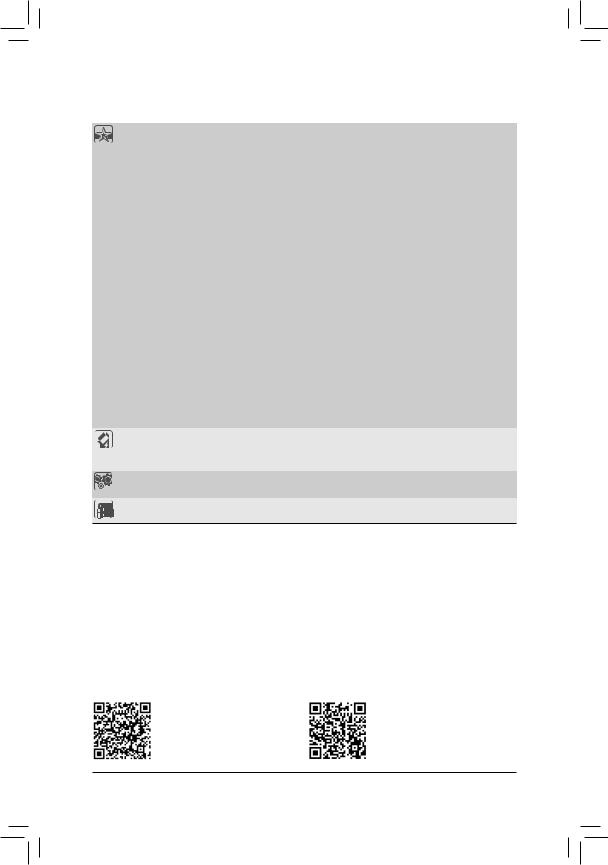
Unique Features |
|
Support for APP Center |
||
|
|
|
* Available applications in APP Center may vary by motherboard model. Supported |
|
|
|
|
functionsofeachapplicationmayalsovarydependingonmotherboardspecifications. |
|
|
|
- |
3D OSD |
|
|
|
- |
@BIOS |
|
|
|
- |
AutoGreen |
|
|
|
- |
Cloud Station |
|
|
|
- |
EasyTune |
|
|
|
- |
Easy RAID |
|
|
|
- |
Fast Boot |
|
|
|
- |
Game Boost |
|
|
|
- |
Platform Power Management |
|
|
|
- |
RGB Fusion |
|
|
|
- |
Smart Backup |
|
|
|
- |
Smart Keyboard |
|
|
|
- |
Smart TimeLock |
|
|
|
- |
Smart HUD |
|
|
|
- |
Smart Survey |
|
|
|
- |
System Information Viewer |
|
|
|
- |
USB Blocker |
|
|
|
- |
USB TurboCharger |
|
|
|
Support for Q-Flash |
||
|
Support for Xpress Install |
|||
Bundled |
|
Norton® Internet Security (OEM version) |
||
Software |
|
cFosSpeed |
||
|
XSplit Gamecaster + Broadcaster (12 months license) |
|||
Operating |
Support for Windows 10 64-bit |
|||
System |
||||
|
|
|
||
Form Factor |
|
E-ATX Form Factor; 30.5cm x 27.1cm |
||
*GIGABYTE reserves the right to make any changes to the product specifications and product-related information without prior notice.
Please visit GIGABYTE's website for support lists of CPU, memory modules, SSDs, and M.2 devices.
Please visit the Support\Utility List page on GIGABYTE's website to download the latest version of apps.
- 13 - |
Hardware Installation |
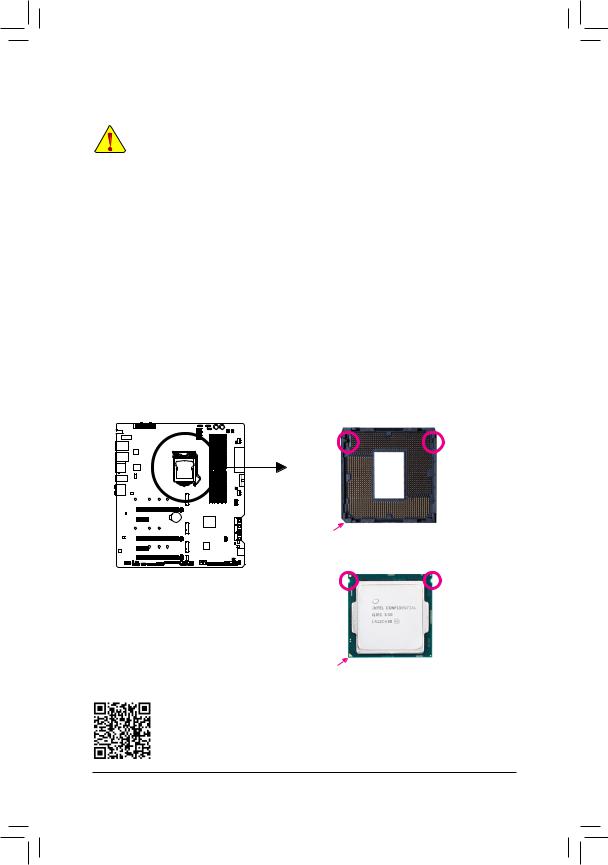
1-3 |
Installing the CPU and CPU Cooler |
|
|
Read the following guidelines before you begin to install the CPU: |
|
|
•• |
Make sure that the motherboard supports the CPU. |
|
|
(Go to GIGABYTE's website for the latest CPU support list.) |
|
•• |
Always turn off the computer and unplug the power cord from the power outlet before installing the |
|
|
CPU to prevent hardware damage. |
|
•• |
Locate the pin one of the CPU. The CPU cannot be inserted if oriented incorrectly. (Or you may |
|
|
locate the notches on both sides of the CPU and alignment keys on the CPU socket.) |
|
•• |
Apply an even and thin layer of thermal grease on the surface of the CPU. |
|
•• |
Do not turn on the computer if the CPU cooler is not installed, otherwise overheating and damage |
|
|
of the CPU may occur. |
|
•• |
Set the CPU host frequency in accordance with the CPU specifications. It is not recommended |
|
|
that the system bus frequency be set beyond hardware specifications since it does not meet the |
|
|
standard requirements for the peripherals. If you wish to set the frequency beyond the standard |
|
|
specifications, please do so according to your hardware specifications including the CPU, graphics |
|
|
card, memory, hard drive, etc. |
1-3-1 Installing the CPU
A. Locate the alignment keys on the motherboard CPU socket and the notches on the CPU.
LGA1151 CPU Socket
Alignment Key |
Alignment Key |
Pin One Corner of the CPU Socket
|
LGA1151 CPU |
Notch |
Notch |
Triangle Pin One Marking on the CPU
Please visit GIGABYTE's website for details on hardware installation.
Hardware Installation |
- 14 - |
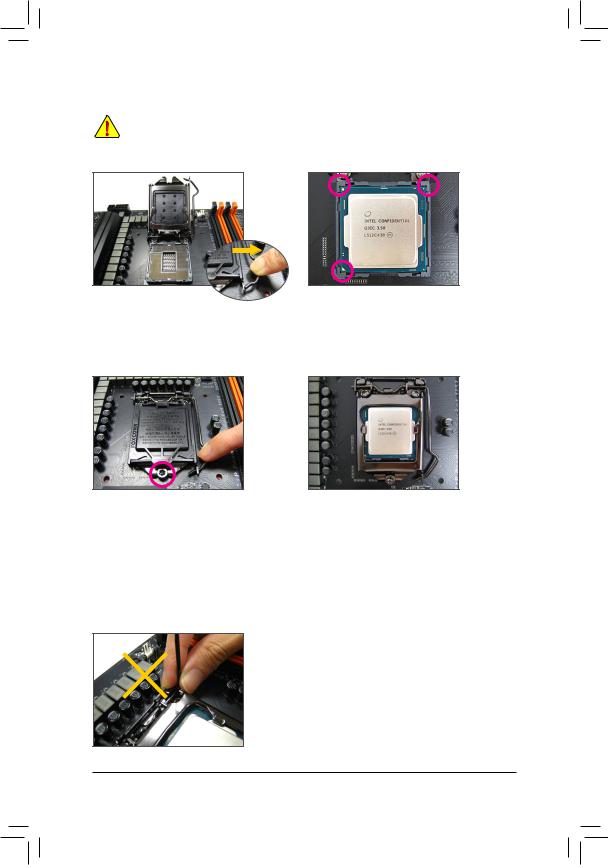
B. Follow the steps below to correctly install the CPU into the motherboard CPU socket.
•• Before installing the CPU, make sure to turn off the computer and unplug the power cord from the power outlet to prevent damage to the CPU.
•• To protect the socket contacts, do not remove the protective plastic cover unless the CPU is inserted into the CPU socket. Save the cover properly and replace it if the CPU is removed.
Step 1:
Gently press the CPU socket lever handle down and away from the socket with your finger. Then completely lift the CPU socket lever and the metal load plate/plastic cover will be lifted as well.
Step 3:
Once the CPU is properly inserted, carefully replace the load plate. When replacing the load plate, make sure the front end of the load plate is under the shoulder screw. Then press the CPU socket lever. The protective plastic cover may pop off from the load plate during the process of engaging the lever. Remove the cover. (Save the cover properly and always replace it when the CPU is not installed.)
Step 2:
Hold the CPU with your thumb and index fingers.
Align the CPU pin one marking (triangle) with the pin one corner of the CPU socket (or you may align the CPU notches with the socket alignment keys) and gently insert the CPU into position.
Step 4:
Finally, secure the lever under its retention tab to complete the installation of the CPU.
NOTE:
Hold the CPU socket lever by the handle, not the lever base portion.
- 15 - |
Hardware Installation |
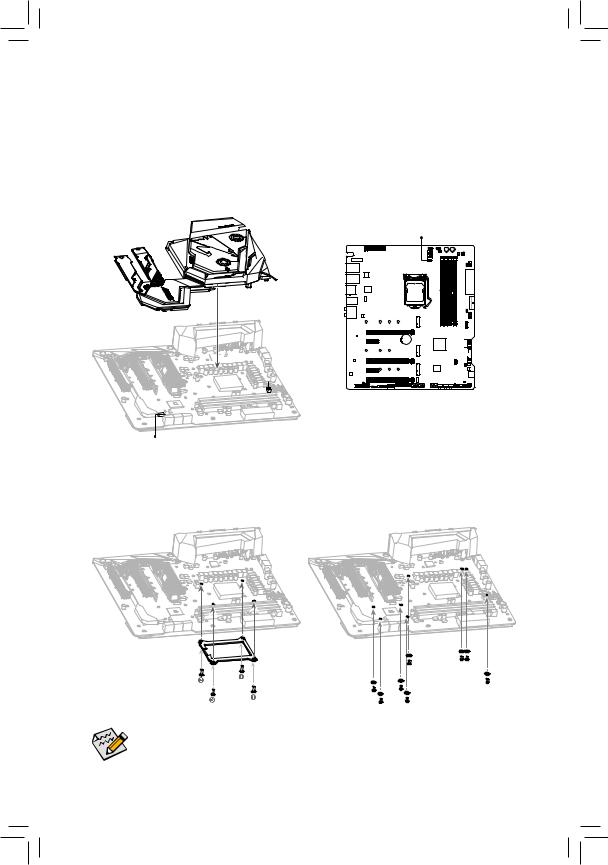
1-3-2 Installing the Water Cooling Kit
Refer to the pictures below to install the water cooling kit on the motherboard. Step 1:
Apply an even and thin layer of thermal grease on the surface of the installed CPU. Gently take the water cooling kit out of its package. Align it with the motherboard in the direction as indicated below, connect the LED cables from the water cooling kit to the LED_CPU and LED_PCH headers on the motherboard. Then place the water cooling kit vertically on the motherboard.
LED_CPU





 LED_PCH
LED_PCH
 LED_CPU
LED_CPU
LED_PCH
Step 2:
Carefully flip the motherboard over, fasten the CPU backplate and the four screws in a diagonal sequence.
Tighten the remaining 8 screws to their corresponding holes. Make sure the water cooling kit is securely attached. After completing the steps above, connect your water cooling components.
•• |
Before installing the water cooling kit, remove the protective film first. |
|
•• |
The water cooling kit provides two G1/4" threaded fittings. Please choose the barbs (not included) |
|
|
that suit your requirements. |
|
|
|
|
Hardware Installation |
- 16 - |
|
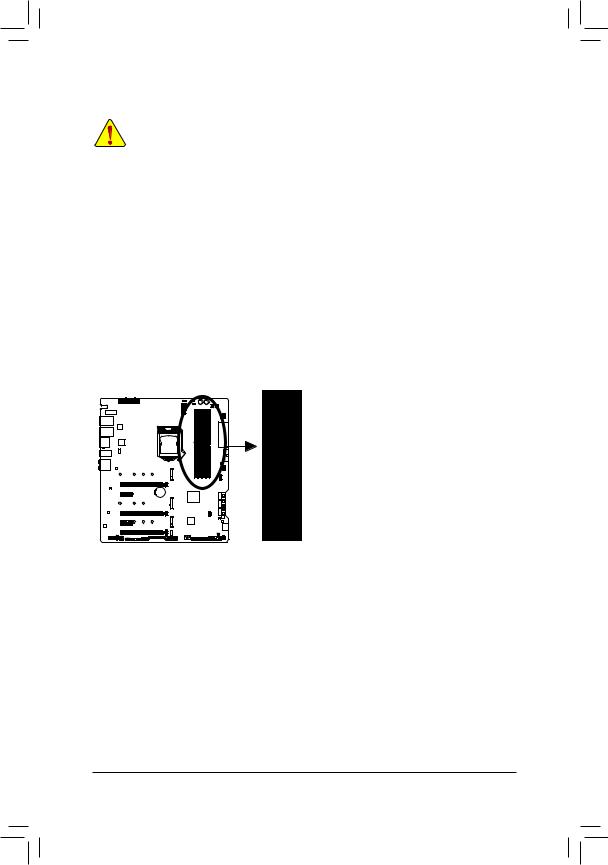
1-4 Installing the Memory
Read the following guidelines before you begin to install the memory:
•• Make sure that the motherboard supports the memory. It is recommended that memory of the same capacity, brand, speed, and chips be used.
(Go to GIGABYTE's website for the latest supported memory speeds and memory modules.)
•• Always turn off the computer and unplug the power cord from the power outlet before installing the memory to prevent hardware damage.
•• Memory modules have a foolproof design. A memory module can be installed in only one direction. If you are unable to insert the memory, switch the direction.
1-4-1 Dual Channel Memory Configuration
This motherboard provides four memory sockets and supports Dual Channel Technology. After the memory is installed, the BIOS will automatically detect the specifications and capacity of the memory. Enabling Dual
Channel memory mode will double the original memory bandwidth.
The four memory sockets are divided into two channels and each channel has two memory sockets as following:
Channel A: DDR4_A1, DDR4_A2Channel B: DDR4_B1, DDR4_B2
Dual Channel Memory Configurations Table
|
|
DDR4_A1 |
DDR4_A2 |
DDR4_B1 |
DDR4_B2 |
2 Modules |
- - |
DS/SS |
- - |
DS/SS |
|
|
|
DS/SS |
- - |
DS/SS |
- - |
4 Modules |
DS/SS |
DS/SS |
DS/SS |
DS/SS |
|
|
|
|
|
|
|
(SS=Single-Sided, DS=Double-Sided, "- -"=No Memory)
DDR4_B2
DDR4_B1
DDR4_A2
DDR4_A1
Due to CPU limitations, read the following guidelines before installing the memory in Dual Channel mode.
1.Dual Channel mode cannot be enabled if only one memory module is installed.
2.When enabling Dual Channel mode with two or four memory modules, it is recommended that memory of the same capacity, brand, speed, and chips be used.
- 17 - |
Hardware Installation |
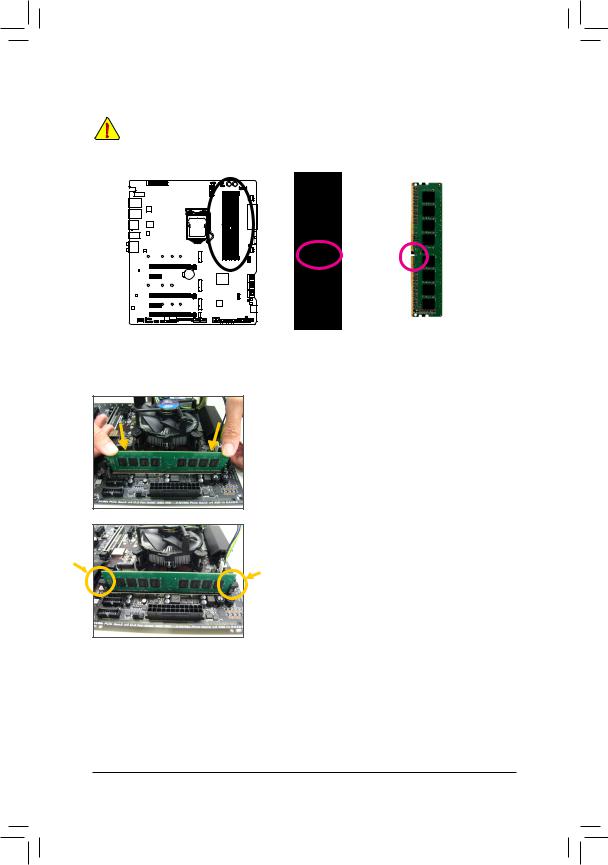
1-4-2 Installing a Memory
Before installing a memory module, make sure to turn off the computer and unplug the power cord from the power outlet to prevent damage to the memory module. DDR4 and DDR3 DIMMs are not compatible to each other or DDR2 DIMMs. Be sure to install DDR4 DIMMs on this motherboard.
Notch
DDR4 DIMM
ADDR4 memory module has a notch, so it can only fit in one direction. Follow the steps below to correctly install your memory modules in the memory sockets.
Step 1:
Note the orientation of the memory module. Spread the retaining clips at both ends of the memory socket. Place the memory module on the socket. As indicated in the picture on the left, place your fingers on the top edge of the memory, push down on the memory and insert it vertically into the memory socket.
Step 2:
The clips at both ends of the socket will snap into place when the memory module is securely inserted.
Hardware Installation |
- 18 - |
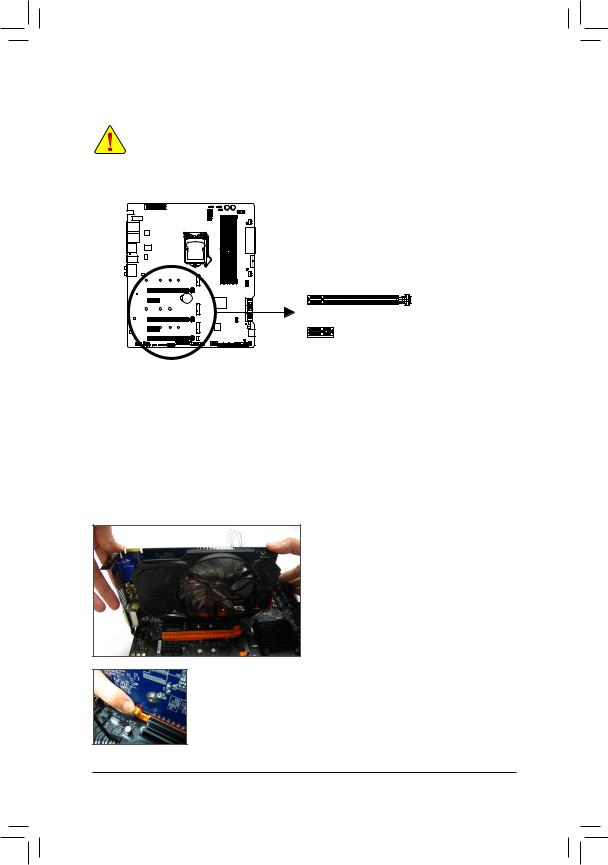
1-5 Installing an Expansion Card
Read the following guidelines before you begin to install an expansion card:
•• Make sure the motherboard supports the expansion card. Carefully read the manual that came with your expansion card.
•• Always turn off the computer and unplug the power cord from the power outlet before installing an expansion card to prevent hardware damage.
PCI Express x16 Slot
PCI Express x1 Slot
Follow the steps below to correctly install your expansion card in the expansion slot.
1.Locate an expansion slot that supports your card. Remove the metal slot cover from the chassis back panel.
2.Align the card with the slot, and press down on the card until it is fully seated in the slot.
3.Make sure the metal contacts on the card are completely inserted into the slot.
4.Secure the card's metal bracket to the chassis back panel with a screw.
5.After installing all expansion cards, replace the chassis cover(s).
6.Turn on your computer. If necessary, go to BIOS Setup to make any required BIOS changes for your expansion card(s).
7.Install the driver provided with the expansion card in your operating system.
Example: Installing and Removing a PCI Express Graphics Card
•• Installing a Graphics Card:
Gently push down on the top edge of the card until it is fully inserted into the PCI Express slot. Make sure the card is securely seated in the slot and does not rock.
•• Removing the Card:
Gently push back on the lever on the slot and then lift the card straight out from the slot.
- 19 - |
Hardware Installation |
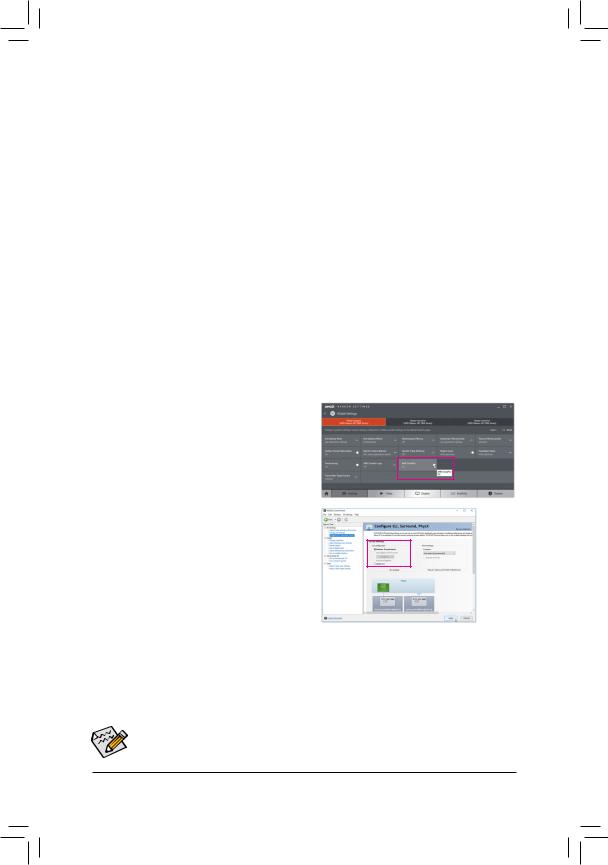
1-6 Setting up AMD CrossFire™/NVIDIA® SLI™ Configuration
A.System Requirements
-- Windows 10 64-bit operating system
-- A CrossFire/SLI-supported motherboard with two PCI Express x16 slots and correct driver -- CrossFire/SLI-ready graphics cards of identical brand and chip and correct driver
(For the latest GPUs that support the 3-way CrossFire technology, please refer to the AMD website.) (Note 1) -- CrossFire (Note 2)/SLI bridge connectors
-- A power supply with sufficient power is recommended (Note 3) (Refer to the manual of your graphics cards for the power requirement)
B.Connecting the Graphics Cards
Step 1:
Observe the steps in "1-5 Installing an Expansion Card" and install the graphics cards on the PCIEX16 and PCIEX8 slots.
Step 2:
Insert the CrossFire (Note 2)/SLI bridge connectors in the CrossFire/SLI gold edge connectors on top of the cards.
Step 3:
Plug the display cable into the graphics card on the PCIEX16 slot.
C. Configuring the Graphics Card Driver
C-1. To Enable CrossFire Function
After installing the graphics card driver in the operating system, go to the AMD RADEON SETTINGS screen. Browse to Gaming\Global Settings and ensure AMD CrossFire is set to On.
C-2. To Enable SLI Function
After installing the graphics card driver in the operating system, go to the NVIDIA Control Panel. Browse to the
Configure SLI, Surround, Physx screen and ensure
Maximize 3D performance is enabled.
(Note 1) When using dual core graphics cards, only 2-way is supported.
(Note 2) The bridge connector(s) may be needed or not depending on your graphics cards.
(Note 3) When two or more graphics cards are installed, we recommend that you connect the power cable from the power supply to the OC_PEG connector to ensure system stability.
Procedure and driver screen for enabling CrossFire/SLI technology may differ by graphics cards and driver version. Refer to the manual that came with your graphics cards for more information about enabling CrossFire/SLI technology.
Hardware Installation |
- 20 - |
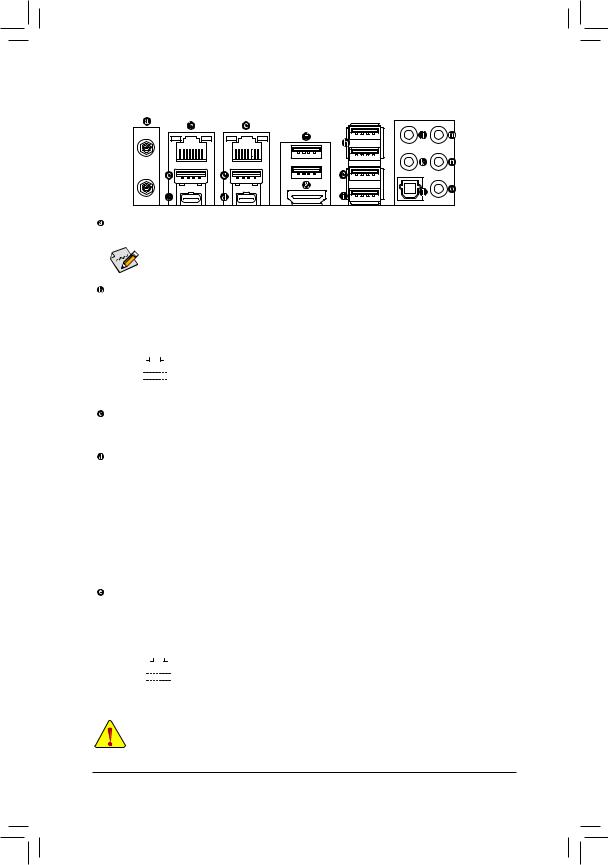
1-7 Back Panel Connectors
SMA Antenna Connectors (2T2R)
Use this connector to connect an antenna.

 Tighten the antenna cables to the antenna connectors and then move the antenna to a place
Tighten the antenna cables to the antenna connectors and then move the antenna to a place
where the signal is good.
RJ-45 LAN Port (LAN2)
The Gigabit Ethernet LAN port provides Internet connection at up to 1 Gbps data rate. The following describes the states of the LAN port LEDs.
Connection/ |
|
|
|
|
|
|
|
|
Connection/Speed LED: |
|
Activity LED: |
|
|||||||
Speed LED |
|
|
|
Activity LED |
|
|
|||||||||||||
|
|
|
|
|
|
|
|||||||||||||
|
|
|
|
|
|
|
|
|
|
|
|
|
|
|
State |
Description |
|
State |
Description |
|
|
|
|
|
|
|
|
|
|
|
|
|
|
|
Orange |
1 Gbps data rate |
|
Blinking |
Data transmission or receiving is occurring |
|
|
|
|
|
|
|
|
|
|
|
|
|
|
|
Green |
100 Mbps data rate |
|
On |
No data transmission or receiving is occurring |
|
|
|
|
|
|
|
|
|
|
|
|
|
|
|
Off |
10 Mbps data rate |
|
||
|
|
|
|
|
|
|
|
|
|
|
|
|
|
|
|
|
|
||
|
|
|
|
LAN Port |
|
|
|
||||||||||||
|
|
|
|
|
|
|
|
|
|||||||||||
USB 3.1 Gen 2 Type-A Port (Red)
The USB 3.1 Gen 2 Type-A port supports the USB 3.1 Gen 2 specification and is compatible to the USB 3.1 Gen 1 and USB 2.0 specification. Use this port for USB devices.
Thunderbolt™ 3 Connector (USB Type-C™ Port)
The connector supports standard DisplayPort and Thunderbolt™ video outputs. You can connect a standard DisplayPort/Thunderbolt™ monitor to this connector with an adapter. The Thunderbolt™ connector can daisy chain up to six Thunderbolt™ devices. Because of the limited I/O resources of the PC architecture, the number of Thunderbolt™ devices that can be used is dependent on the number of the PCI Express devices being installed. You can adjust the Thunderbolt™ settings under Peripherals\Thunderbolt(TM)
Configuration in BIOS Setup. The maximum supported resolution is 4096x2304@60 Hz when using a
DisplayPort monitor, but the actual resolutions supported are dependent on the monitor being used. Also, the connector is reversible and supports the USB 3.1 Gen 2 specification and is compatible to the USB 3.1 Gen 1 and USB 2.0 specification. You can use this port for USB devices, too.
RJ-45 LAN Port (LAN1)
The Gigabit Ethernet LAN port provides Internet connection at up to 10 GB data rate. The following describes the states of the LAN port LEDs.
|
|
|
|
|
|
|
|
|
Connection/ |
Speed LED: |
|
Connection/Activity LED: |
|||||||
Speed LED Activity LED |
|
||||||||||||||||||
|
|
|
|
|
|||||||||||||||
|
|
|
|
|
|
|
|
|
|
|
|
|
|
|
State |
Description |
|
State |
Description |
|
|
|
|
|
|
|
|
|
|
|
|
|
|
|
Green |
10 Gbps data rate |
|
Blinking |
Data transmission or receiving is occurring |
|
|
|
|
|
|
|
|
|
|
|
|
|
|
|
Orange |
5 Gbps/ 2.5 Gbps/ 1 Gbps/ |
|
On |
No data transmission or receiving is |
|
|
|
|
|
|
|
|
|
|
|
|
|
|
|
|
100 Mbps data rate |
|
|
occurring |
|
|
|
|
|
|
|
|
|
|
|
|
|
|
|
|
|
|
||
|
|
|
|
LAN Port |
|
|
|
|
|
||||||||||
|
|
|
|
|
|
|
|
|
|||||||||||
•• When removing the cable connected to a back panel connector, first remove the cable from your device and then remove it from the motherboard.
•• When removing the cable, pull it straight out from the connector. Do not rock it side to side to prevent an electrical short inside the cable connector.
- 21 - |
Hardware Installation |

USB 2.0/1.1 Port
The USB port supports the USB 2.0/1.1 specification. Use this port for USB devices.
HDMI Port
 The HDMI port supports HDCP 2.2 and Dolby TrueHD and DTS HD Master
The HDMI port supports HDCP 2.2 and Dolby TrueHD and DTS HD Master












 Audio formats. It also supports up to 192KHz/16bit 8-channel LPCM audio output. You can use this port to connect your HDMI-supported monitor. The maximum supported resolution is 4096x2160@30 Hz, but the actual resolutions supported are dependent on the monitor being used.
Audio formats. It also supports up to 192KHz/16bit 8-channel LPCM audio output. You can use this port to connect your HDMI-supported monitor. The maximum supported resolution is 4096x2160@30 Hz, but the actual resolutions supported are dependent on the monitor being used.
 After installing the HDMI device, make sure to set the default sound playback device to HDMI.
After installing the HDMI device, make sure to set the default sound playback device to HDMI.
(The item name may differ depending on your operating system.)
USB 3.1 Gen 1 Port
The USB 3.1 Gen 1 port supports the USB 3.1 Gen 1 specification and is compatible to the USB 2.0 specification. Use this port for USB devices.
USB 3.1 Gen 2 Type-A Port (Red)
The USB 3.1 Gen 2 Type-A port supports the USB 3.1 Gen 2 specification and is compatible to the USB 3.1 Gen 1 and USB 2.0 specification. Use this port for USB devices. Before using Q-Flash Plus, make sure to insert the USB flash drive(Note) into this port first.
Center/Subwoofer Speaker Out
Use this audio jack to connect center/subwoofer speakers.
Rear Speaker Out
Use this audio jack to connect rear speakers.
Optical S/PDIF Out Connector
This connector provides digital audio out to an external audio system that supports digital optical audio. Before using this feature, ensure that your audio system provides an optical digital audio in connector.
Line In/Side Speaker Out
The line in jack. Use this audio jack for line in devices such as an optical drive, walkman, etc.
Line Out/Front Speaker Out
The line out jack. This jack supports audio amplifying function. Actual effects may vary by the device being used.
Mic In/Side Speaker Out
The Mic in jack.
Audio Jack Configurations:
Jack |
Headphone/ |
4-channel |
5.1-channel |
7.1-channel |
|
2-channel |
|||||
|
|
|
|
||
Center/Subwoofer Speaker |
|
|
a |
a |
|
Out |
|
|
|||
|
|
|
|
||
Rear Speaker Out |
|
a |
a |
a |
|
|
|
|
|
|
|
Line In/Side Speaker Out |
|
|
|
a |
|
|
|
|
|
|
|
Line Out/Front Speaker Out |
a |
a |
a |
a |
|
|
|
|
|
|
|
Mic In/Side Speaker Out |
|
|
|
a |
|
|
|
|
|
|
•• If you want to install a Side Speaker, you need to retask either the Line in or Mic in jack to be Side Speaker out through the audio driver.
•• To enable or configure the audio amplifying function for the Line out jack, please access the
HD Audio Manager application.
(Note) The USB flash drive used must be a USB 2.0 flash drive.
Hardware Installation |
- 22 - |
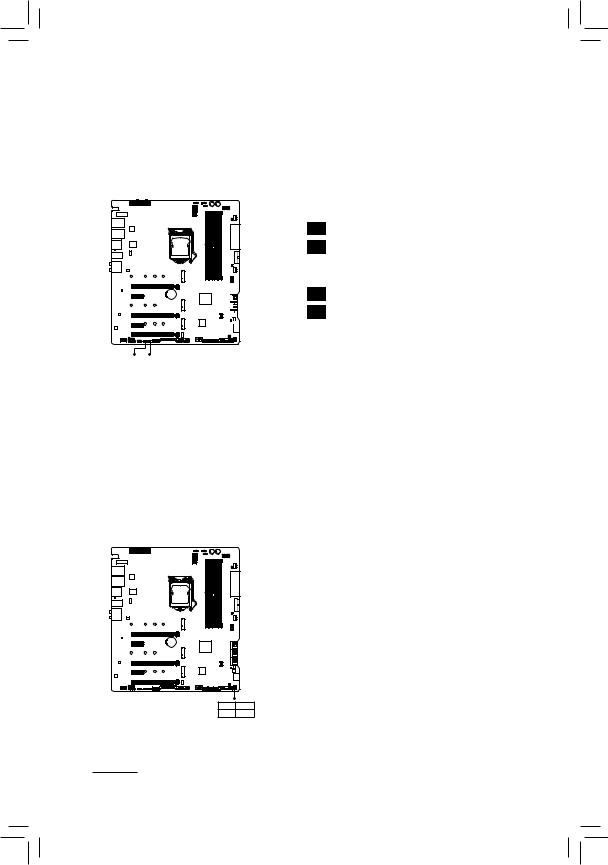
1-8 Onboard Buttons, Switches and LEDs
BIOS Switches and BIOS LED Indicators
The BIOS switch (BIOS_SW) allows users to easily select a different BIOS for boot up or overclocking, helping to reduce BIOS failure during overclocking. The SB switch allows enabling or disabling of the Dual BIOS function. The LED indicator (MBIOS_LED/BBIOS_LED) shows which BIOS is active.
BIOS_SW







 BBIOS_LED
BBIOS_LED



 MBIOS_LED
MBIOS_LED
BIOS_SW SB
1 |
2 |
1: Main BIOS (Boot from the main BIOS) |
1 |
2 |
2: Backup BIOS (Boot from the backup BIOS) |
SB |
|
|
1 |
2 |
1: Dual BIOS |
1 |
2 |
2: Single BIOS |
BIOS LED Indicators:
MBIOS_LED (The main BIOS is active)
BBIOS_LED (The backup BIOS is active)
 Before setting the SB switch, be sure to turn off your computer and power supply.
Before setting the SB switch, be sure to turn off your computer and power supply.
Status LEDs
The status LEDs show whether the CPU, memory, graphics card, and operating system are working properly after system power-on. If the CPU/DRAM/VGA LED is on, that means the corresponding device is not working normally; if the BOOT LED is on, that means you haven't entered the operating system yet.
CPU: CPU status LED
DRAM: Memory status LED
VGA: Graphics card status LED
BOOT: Operating system status LED
CPU |
DRAM |
VGA |
BOOT |
- 23 - |
Hardware Installation |

Quick Buttons
This motherboard has 3 quick buttons: power button, reset button and clear CMOS button. The power button and reset button allow users to quickly turn on/off or reset the computer in an open-case environment when they want to change hardware components or conduct hardware testing. Use this button to clear the BIOS configuration and reset the CMOS values to factory defaults when needed.
 PW_SW
PW_SW 





 CMOS_SW
CMOS_SW




 RST_SW
RST_SW
PW_SW: Power Button
RST_SW: Reset Button
CMOS_SW: Clear CMOS Button
•• Always turn off your computer and unplug the power cord from the power outlet before clearing the CMOS values.
•• NOTE: Do not use the clear CMOS button when the system is on, or the system may shutdown and data loss or damage may occur.
•• After system restart, go to BIOS Setup to load factory defaults (select Load Optimized Defaults) or manuallyconfiguretheBIOSsettings(refertoChapter2,"BIOSSetup,"forBIOSconfigurations).
OC Button
The OC button helps enthusiasts and overclockers not only get the most performance from their hardware, but also the absolute most enjoyable OC experience.
 OC
OC
OC Button:
Press this button to load the most optimized GIGABYTE overclocking configuration for your hardware.
Hardware Installation |
- 24 - |
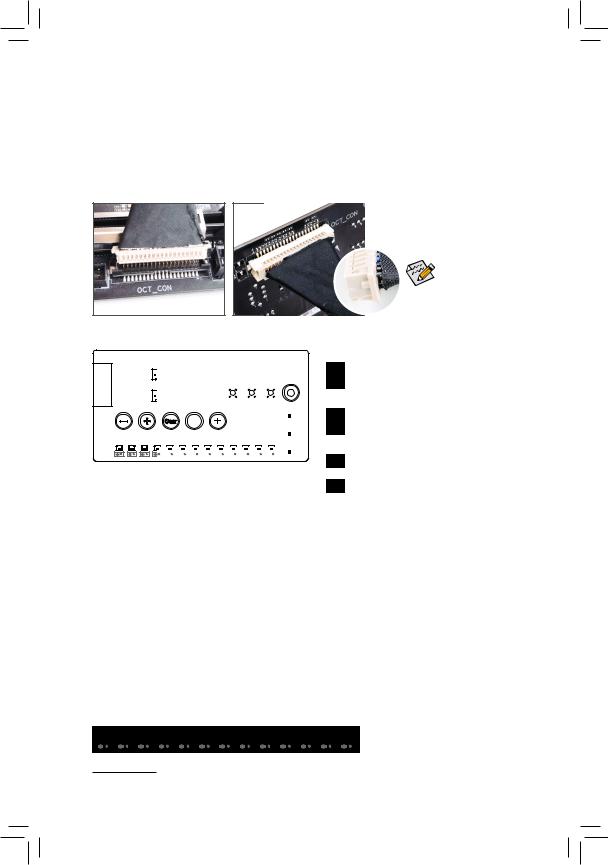
1-9 Installing the GC-OC Touch
The GC-OC Touch add-in card helps enthusiasts and overclockers not only get the most performance from their hardware, but also the absolute most enjoyable OC experience.
A. Connecting the GC-OC Touch to the Motherboard
Connect one end of the GC-OC Touch cable to the OCT_CON header on motherboard, then connect the other end to the OCT_CON header on the back of the GC-OC Touch add-in card.
The OCT_CON header possesses a foolproof design. Be sure to connect the cable in the correct orientation.
B. GC-OC Touch Headers, Switches, and Buttons
|
|
|
FAN_0 |
FAN_1 |
FAN_2 |
|
CLEAR BAT |
CLEAR CMOS |
GC-OC Touch |
||||
PWR |
|
|
FAN_3 |
FAN_4 |
FAN_5 |
|
|
RESET |
POWER |
||||
4PIN |
|
|
|
|
|
|
|
|
|
|
|
|
|
BCLK- |
BCLK+ |
GEAR |
RATIORATIO+ |
|
|
|
SB |
||||||
VCORE |
VAXG |
VDIMM |
DDRVTT |
PCHIO |
VCCPLL |
|
VCCIO |
VCCST |
VCCIO1 |
PLL OC |
VCCIO2 |
VPP 25V |
IGPU |
VSA |
TGR |
||||||||||||
|
|
|
|
|
|
|
|
|
|
|
|
|
|
4PIN_PWR:
Connect the 4-pin power cable from the power supply to this connector to provide stable power to the fans connected.
FAN_0~FAN_5:
There are a total of six fan headers.
CLEAR_BAT:
Provides the same function as removing the battery from the battery holder. Pressing this button clears date, time information and BIOS settings.
CLEAR_CMOS:
Clears BIOS settings and resets the CMOS values to factory defaults.
RESET:
The reset button.
POWER:
The power button.
Onboard Voltage Measurement Module:
Use a multimeter to measure the following motherboard voltages.
SB Switch:
1 |
2 |
1: Dual BIOS |
1 |
2 |
2: Single BIOS |
IGPU Switch: |
||
1 |
2 |
1: Enables CPU's integrated graphics |
1 |
2 |
2: Disables CPU's integrated graphics |
TGR Switch: |
||
1 |
2 |
1: Target frequency set in BIOS Setup or other |
|
|
overclocking application. |
1 |
2 |
2: Safe frequency (using the lowest CPU ratio, |
|
|
which may vary by CPU) |
BCLK-:
Lowers the CPU base clock.
BCLK+:
Raises the CPU base clock.
Gear:
Changes BCLK stepping to 0.1 MHz or 1 MHz.
RATIO-:
Lowers the CPU ratio.
RATIO+:
Raises the CPU ratio.
|
VCORE |
|
VAXG |
|
VDIMM |
|
DDRVTT |
|
PCHIO |
|
VCCPLL |
|
VSA |
|
VCCIO |
|
VCCST |
|
VCCIO1 |
|
|
PLL OC |
|
|
VCCIO2 |
|
|
VPP 25V |
|
|
|
|
|
|
|
|
|
|
|
|
|
|
|
|
|
|
|
|
|
|
|
|
|
|
|
|
|
|
|
|
|
|
|
|
|
|
|
|
|
|
|
|
|
|
|
|
|
|
|
|
|
|
|
|
|
|
|
|
|
|
|
|
|
|
|
|
|
|
|
|
|
|
|
|
|
|
|
|
|
|
|
|
|
|
|
|
|
|
|
|
|
|
|
|
|
|
|
|
|
|
|
|
|
|
|
|
|
|
|
|
|
|
|
|
|
|
|
|
|
- 25 - |
Hardware Installation |
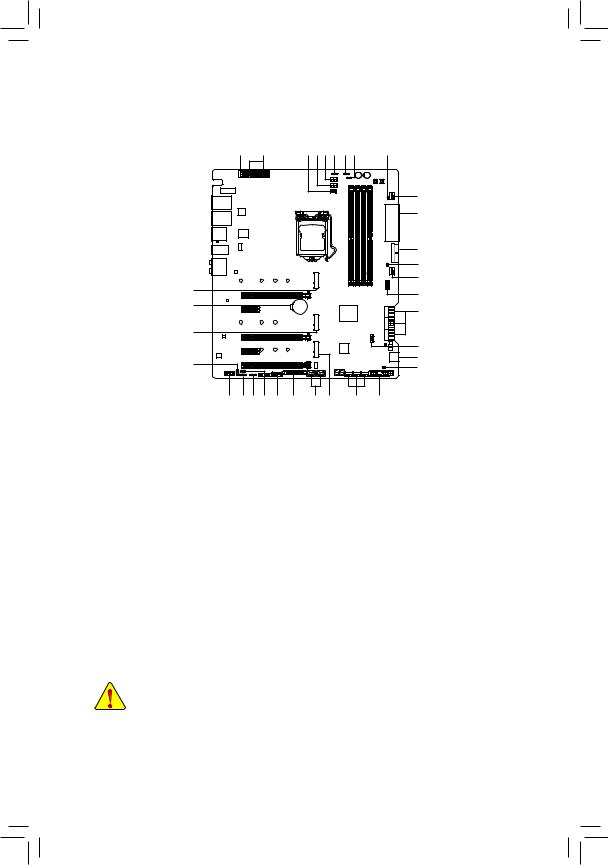
1-10 Internal Connectors
5 |
1 |
8 |
7 4 12 1113 |
10 |
|
|
|
|
6 |
|
|
|
|
2 |
|
|
|
|
21 |
|
|
|
|
10 |
14 |
|
|
|
6 |
|
|
|
20 |
|
24 |
|
|
|
|
|
|
|
15 |
|
|
|
|
|
|
14 |
|
|
|
|
|
|
|
|
9 |
19 |
|
|
|
3 |
|
|
|
25 |
18 |
12 11 13 23 |
16 |
22 |
14 |
5 |
17 |
1) |
ATX_12V_2X4_1/ATX_12V_2X4_2 |
14) |
M2M/M2A/M2P |
|
2) |
ATX |
15) |
SATA3 0/1/2/3/4/5 |
|
3) |
OC_PEG |
16) |
OCT_CON |
|
4) |
CPU_FAN |
17) |
F_PANEL |
|
5) |
SYS_FAN1/2/3/4 |
18) |
F_AUDIO |
|
6) |
SYS_FAN5_PUMP/SYS_FAN6_PUMP |
19) |
SPDIF_O |
|
7) |
CPU_OPT |
20) |
F_USB31C |
|
8) |
LED_CPU |
21) |
F_USB30 |
|
9) |
LED_PCH |
22) |
F_USB1/F_USB2 |
|
10) |
EC_TEMP1/EC_TEMP2 |
23) |
TPM |
|
11) |
LED_C1/LED_C2 |
24) |
BAT |
|
12) |
D_LED1/D_LED2 |
25) |
CLR_CMOS |
|
13) |
DLED_V_SW1/DLED_V_SW2 |
|
|
|
|
Read the following guidelines before connecting external devices: |
|||
|
•• |
First make sure your devices are compliant with the connectors you wish to connect. |
||
|
•• |
Before installing the devices, be sure to turn off the devices and your computer. Unplug the power |
||
|
|
cord from the power outlet to prevent damage to the devices. |
||
|
•• |
After installing the device and before turning on the computer, make sure the device cable has |
||
|
|
been securely attached to the connector on the motherboard. |
||
|
|
|
||
Hardware Installation |
- 26 - |
|
||
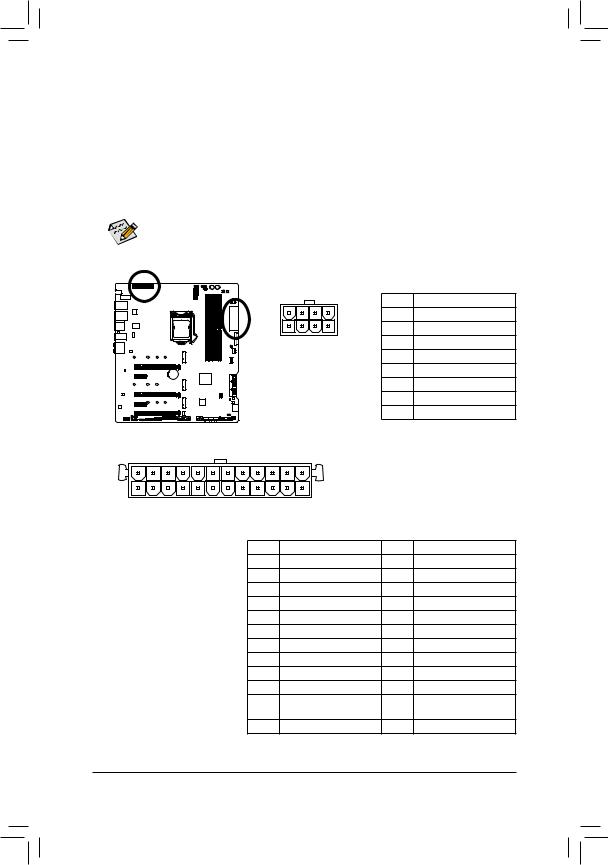
1/2) ATX_12V_2X4_1/ATX_12V_2X4_2/ATX (2x4 12V Power Connector and 2x12 Main Power Connector)
With the use of the power connector, the power supply can supply enough stable power to all the components on the motherboard. Before connecting the power connector, first make sure the power supply is turned off and all devices are properly installed. The power connector possesses a foolproof design. Connect the power supply cable to the power connector in the correct orientation.
The 12V power connector mainly supplies power to the CPU. If the 12V power connector is not connected, the computer will not start.
To meet expansion requirements, it is recommended that a power supply that can withstand high power consumption be used (500W or greater). If a power supply is used that does not provide the required power, the result can lead to an unstable or unbootable system.
|
|
|
ATX_12V_2X4_1/ATX_12V_2X4_2: |
|
|
|
|
Pin No. |
Definition |
|
5 |
8 |
1 |
GND (Only for 2x4-pin 12V) |
|
1 |
4 |
2 |
GND (Only for 2x4-pin 12V) |
|
|
ATX_12V_2X4_1/ |
3 |
GND |
|
|
ATX_12V_2X4_2 |
4 |
GND |
|
|
|
5 |
+12V (Only for 2x4-pin 12V) |
|
|
|
6 |
+12V (Only for 2x4-pin 12V) |
|
|
|
7 |
+12V |
|
|
|
8 |
+12V |
24 |
|
13 |
|
|
12 |
ATX |
1 |
|
|
|
|
|
|
|
|
ATX: |
|
|
|
|
Pin No. |
Definition |
Pin No. |
Definition |
|
1 |
3.3V |
13 |
3.3V |
|
2 |
3.3V |
14 |
-12V |
|
3 |
GND |
15 |
GND |
|
4 |
+5V |
16 |
PS_ON (soft On/Off) |
|
5 |
GND |
17 |
GND |
|
6 |
+5V |
18 |
GND |
|
7 |
GND |
19 |
GND |
|
8 |
Power Good |
20 |
NC |
|
9 |
5VSB (stand by +5V) |
21 |
+5V |
|
10 |
+12V |
22 |
+5V |
|
11 |
+12V (Only for 2x12-pin |
23 |
+5V (Only for 2x12-pin ATX) |
|
|
ATX) |
|
|
|
12 |
3.3V (Only for 2x12-pin ATX) |
24 |
GND (Only for 2x12-pin ATX) |
- 27 - |
Hardware Installation |
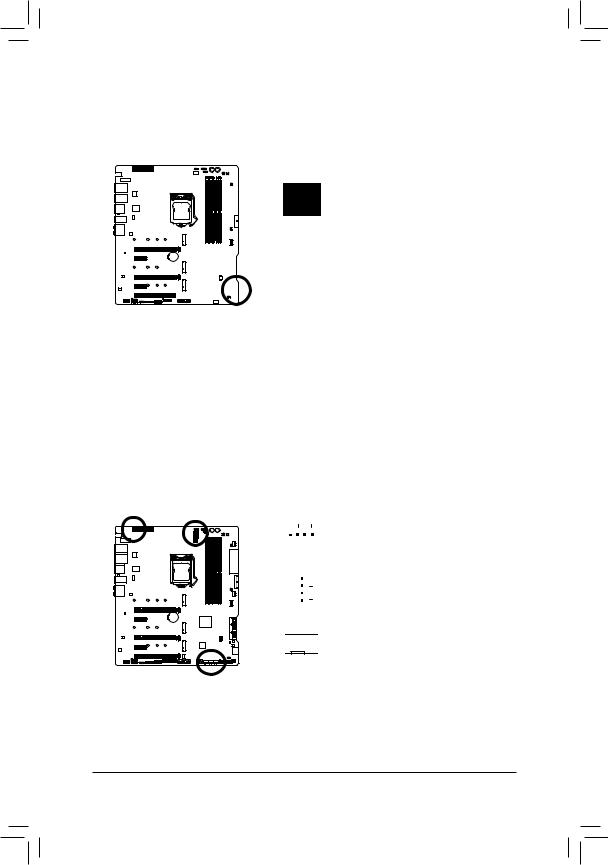
3)OC_PEG (PCIe Power Connector)
The power connector provides auxiliary power to the onboard PCI Express x16 slots. When two or more graphics cards are installed, we recommend that you connect the 2x3 power cable from the power supply to this connector to ensure system stability.
|
|
|
|
|
|
|
Pin No. |
Definition |
|
6 |
4 |
|
1 |
+12V |
3 |
1 |
2 |
+12V |
|
|
|
|
3 |
+12V |
|
|
|
4 |
GND |
|
|
|
5 |
GND |
|
|
|
6 |
GND |
4/5) CPU_FAN/SYS_FAN1/2/3/4 (Fan Headers)
All fan headers on this motherboard are 4-pin. Most fan headers possess a foolproof insertion design. When connecting a fan cable, be sure to connect it in the correct orientation (the black connector wire is the ground wire). The speed control function requires the use of a fan with fan speed control design. For optimum heat dissipation, it is recommended that a system fan be installed inside the chassis.
|
|
|
|
1 |
|
|
|
|
|
|
|
|
|
|
|
|
|
Pin No. |
Definition |
|
|
|
|
|
|
||
CPU_FAN |
|
|||||
|
1 |
GND |
||||
|
|
|
|
|
||
|
|
|
|
|
2 |
Voltage Speed Control |
|
|
|
|
|
3 |
Sense |
|
|
|
|
|
||
|
|
|
1 |
|
4 |
PWM Speed Control |
|
|
|
|
|||
SYS_FAN1 |
|
|
|
|||
1 




 SYS_FAN2/3/4
SYS_FAN2/3/4
Hardware Installation |
- 28 - |
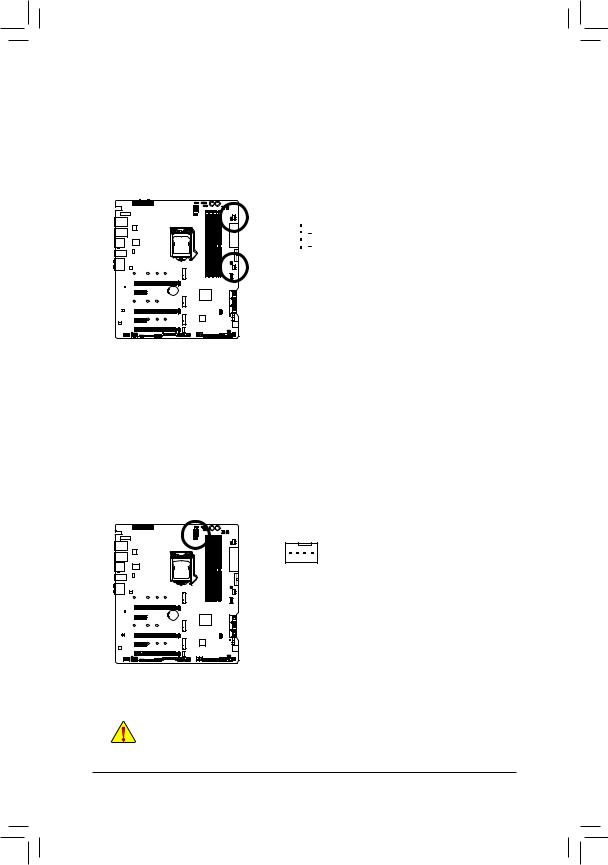
6)SYS_FAN5_PUMP/SYS_FAN6_PUMP (System Fan/Water Cooling Pump Headers)
The fan/pump headers are 4-pin. Most fan headers possess a foolproof insertion design. When connecting a fan cable, be sure to connect it in the correct orientation (the black connector wire is the ground wire). The speed control function requires the use of a fan with fan speed control design. For optimum heat dissipation, it is recommended that a system fan be installed inside the chassis. The headers also provides speed control for a water cooling pump, refer to Chapter 2, "BIOS Setup," "M.I.T.," for more information.
|
|
Pin No. |
Definition |
|
|
1 |
GND |
|
|
2 |
Voltage Speed Control |
|
|
|
|
|
|
3 |
Sense |
1 |
|||
|
|
4 |
PWM Speed Control |
7)CPU_OPT (Water Cooling CPU Fan Header)
The fan header is 4-pin and possesses a foolproof insertion design. Most fan headers possess a foolproof insertion design. When connecting a fan cable, be sure to connect it in the correct orientation (the black connector wire is the ground wire). The speed control function requires the use of a fan with fan speed control design.
|
Pin No. |
Definition |
|
1 |
1 |
GND |
|
2 |
Voltage Speed Control |
||
|
|||
|
3 |
Sense |
|
|
4 |
PWM Speed Control |
•• Be sure to connect fan cables to the fan headers to prevent your CPU and system from overheating. Overheating may result in damage to the CPU or the system may hang.
•• Thesefanheadersarenotconfigurationjumperblocks.Donotplaceajumpercapontheheaders.
- 29 - |
Hardware Installation |
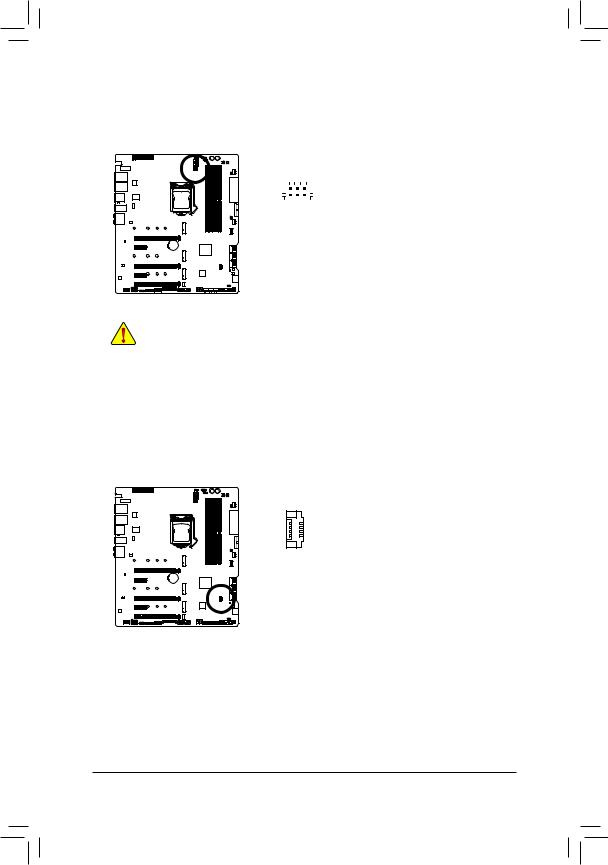
8)LED_CPU (Water Cooling Kit CPU LED Header)
This header provides power and signals to the CPU LED on the water cooling kit. It can detect water cooling leaks, which ensures stable heat dissipation for your system.
|
|
|
Pin No. |
Definition |
|
1 |
|
5 |
1 |
Power |
|
|
|||||
2 |
|
6 |
|
|
|
2 |
Leak Detection |
||||
|
|||||
|
|||||
|
|||||
|
|
|
3 |
LED Signals |
|
|
|
|
4 |
GND |
|
|
|
|
5 |
Reserved |
|
|
|
|
6 |
Reserved |
•• In case a leak occurs, turn off the power supply immediately. Do not turn on the power until the leak is solved.
•• Leak detection efficacy varies by liquid coolants.
9)LED_PCH (Water Cooling Kit Chipset LED Header)
This header provides power and signals to the Chipset LED on the water cooling kit.
1
4
Hardware Installation |
- 30 - |
